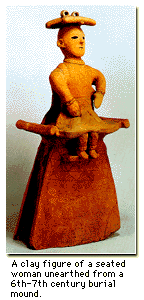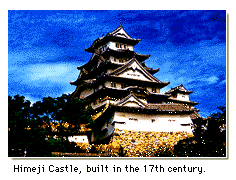 |
 The Japanese archipelago assumed its present shape around 10,000 years ago. Soon after, the era known as the Jomon period began and continued for about 8,000 years. Its people were hunter-gatherers. Gradually, they formed small communities and began to organize their lives communally. They also began to use earthenware objects. The Japanese archipelago assumed its present shape around 10,000 years ago. Soon after, the era known as the Jomon period began and continued for about 8,000 years. Its people were hunter-gatherers. Gradually, they formed small communities and began to organize their lives communally. They also began to use earthenware objects.
Rice cultivation reached Japan from the Eurasian continent around 300 BC during the Yayoi period, and settlements grew larger. Japan can be said to have taken its first steps to nationhood in the Yamato period, which began at the end of the third century AD. During this period, the ancestors of the present Emperor began to bring a number of small states under unified rule from their bases around what are now Nara and Osaka Prefectures. In 604 Prince Shotoku laid down Japan's first constitution. Also from this time, Buddhism that was introduced from the Eurasian continent began to take root in Japan. The Nara period began at the beginning of the eighth century with the establishment of the country's first permanent capital in Nara. Toward the end of the century, the capital was transferred to Kyoto, launching the Heian period, during which noble families predominated and a distinct national culture blossomed. From the Kamakura period, which began at the end of the twelfth century, to the close of the Edo period in the latter half of the nineteenth century, Japan was ruled by samurai, or warrior class. Order broke down around the middle of the fifteenth century, and Japan was torn by civil warfare for nearly 100 years as samurai lords of different domains fought one another. The agent of pacification and national unity was Toyotomi Hideyoshi. |
 At the beginning of the seventeenth century, Tokugawa Ieyasu set up a government in Edo (now Tokyo), and the Edo period began. The Tokugawa regime adopted an isolationist policy that lasted for more than 200 years, cutting off exchange with all countries except China and the Netherlands. But with the arrival of American Commodore Matthew Perry in 1853, the nation began to open itself up to the United States and European powers.
At the beginning of the seventeenth century, Tokugawa Ieyasu set up a government in Edo (now Tokyo), and the Edo period began. The Tokugawa regime adopted an isolationist policy that lasted for more than 200 years, cutting off exchange with all countries except China and the Netherlands. But with the arrival of American Commodore Matthew Perry in 1853, the nation began to open itself up to the United States and European powers.
The age of the samurai came to an end with the Meiji Restoration of 1868, and a new system of government centered on the Emperor was set up. The new government promoted modernization, adopted Western political, social and economic systems, and stimulated industrial activity. The Diet was inaugurated, and the people began to enjoy limited participation in politics. From around 1920 a democratic movement gained strength. But amid a global economic crisis, the military came to the fore, and Japan eventually marched down the road to war. With the end of World War II in 1945 Japan put into effect a new Constitution, committed itself to becoming a peace-seeking democracy, and succeeded in relaunching its economy. In 1956 the nation's entry into the United Nations was approved. Since then, Japan has contributed to world peace and prosperity as a member of the international community. |
| Periods | |
|---|---|
| Paleolithic period | pre- 8,000 BC |
| Jomon period | ca 8,000-ca 300 BC |
| Yayoi period | ca 300 BC-ca AD 300 |
| Yamato period | ca 300 AD-593 |
| Asuka period | 593-710 |
| Nara period | 710-794 |
| Heian period | 794-1192 |
| Kamakura period | 1192-1338 |
| Muromachi period | 1338-1573 |
| Azuchi-Momoyama period | 1573-1603 |
| Edo period | 1603-1868 |
| Meiji era | 1868-1912 |
| Taisho era | 1912-1926 |
| Showa era | 1926-1989 |
| Heisei era | 1989- |
Photos courtesy of Tokyo National Museum and Ministry of Foreign Affairs.

|
